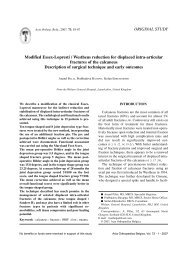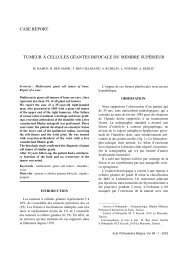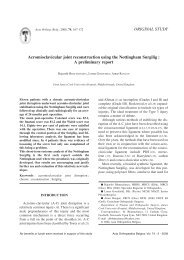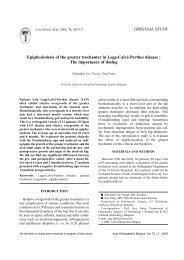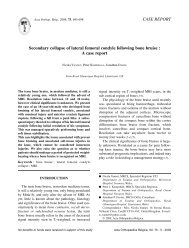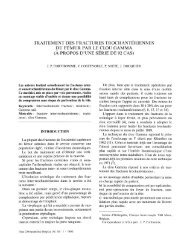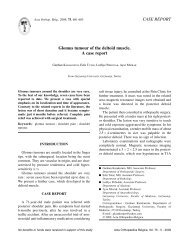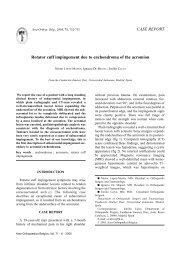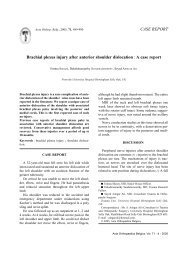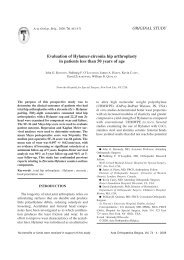Functional reconstruction of the upper extremity in tetraplegia ...
Functional reconstruction of the upper extremity in tetraplegia ...
Functional reconstruction of the upper extremity in tetraplegia ...
Create successful ePaper yourself
Turn your PDF publications into a flip-book with our unique Google optimized e-Paper software.
<strong>Functional</strong> <strong>reconstruction</strong> <strong>of</strong> <strong>the</strong> <strong>upper</strong> <strong>extremity</strong> <strong>in</strong> <strong>tetraplegia</strong><br />
Application <strong>of</strong> Möberg’s and Allieu’s procedures<br />
Daniel WELRAEDS, Abdula Amirali ISMAIL, Ala<strong>in</strong> PARENT<br />
The authors conducted a retrospective study to evaluate<br />
<strong>the</strong> benefit <strong>of</strong> 43 reconstructive procedures and<br />
tendon transfers, performed <strong>in</strong> 37 sessions to restore<br />
hand and arm function <strong>in</strong> 25 tetraplegic patients.<br />
These operative procedures were ei<strong>the</strong>r s<strong>in</strong>gle or<br />
mu l t i p l e, d epend<strong>in</strong>g on <strong>the</strong> pat i e n t s ’ needs fo r<br />
restoration.<br />
The <strong>in</strong>itial cl<strong>in</strong>ical situation was assessed based on a<br />
simplified version <strong>of</strong> <strong>the</strong> <strong>in</strong>ternational classification<br />
<strong>of</strong> Giens, modified <strong>in</strong> Ed<strong>in</strong>burgh.<br />
The results were evaluated through cl<strong>in</strong>ical assessment<br />
and simple functional test<strong>in</strong>g. Gestural ability<br />
was improved <strong>in</strong> more than 80% <strong>of</strong> <strong>the</strong> patients and<br />
functional ga<strong>in</strong> was important <strong>in</strong> more than half .<br />
The authors conclude that selected tetrap l egi c<br />
p atients can benefit from <strong>the</strong>se pro c e d u res. Th e<br />
diversity <strong>of</strong> cl<strong>in</strong>ical situations and <strong>the</strong> variety <strong>of</strong> surgical<br />
procedures result <strong>in</strong>to small scattered series<br />
unfit for statistical analysis, and <strong>the</strong>re is a need for<br />
unequivocal, <strong>in</strong>ternationally recognised assessment<br />
methods.<br />
INTRODUCTION<br />
Tetraplegia is responsible for many problems <strong>in</strong><br />
daily liv<strong>in</strong>g, mostly related to <strong>the</strong> recovery and/or<br />
preservation <strong>of</strong> <strong>in</strong>dependence for <strong>the</strong> tetraplegic<br />
<strong>in</strong>dividual.<br />
In 1976 Hanson et Frankl<strong>in</strong> (9) showed that <strong>the</strong><br />
function <strong>the</strong> tetraplegics want to rega<strong>in</strong> primarily is<br />
<strong>the</strong> use <strong>of</strong> arms and hands. From <strong>the</strong> first attempts<br />
by Royle (19) <strong>in</strong> 1938 to restore <strong>the</strong> function <strong>of</strong><br />
p a ra lysed <strong>in</strong>tr<strong>in</strong>sic mu s cles to <strong>the</strong> assessments<br />
made on large series such as Freehafer’s (7) <strong>in</strong><br />
1998, many operators have tried to improve tendon<br />
t ra n s fer techniques. The studies by Möberg,<br />
Zancolli and Bunnell are outstand<strong>in</strong>g milestones <strong>in</strong><br />
this field.<br />
With <strong>the</strong> population <strong>of</strong> tetraplegics <strong>of</strong> a sp<strong>in</strong>al<br />
unit admitt<strong>in</strong>g around 60 new cases ye a rly,<br />
we attempted between 1986 and 2002, to apply<br />
a simplified fo rm <strong>of</strong> Möberg ’s pr<strong>in</strong>ciples to<br />
25 patients (43 operations).<br />
In short, Möberg stated that high neurological<br />
levels call for restoration <strong>of</strong> simple functions, and<br />
also that arthrodesis must be avoided and tenodesis<br />
must be privileged. The hand must be kept supple<br />
and suitable for contact. He also stated that a<br />
tenodesis is <strong>of</strong>ten stronger and more useful than a<br />
tendon tra n s fe r. All pro c e d u res used must be<br />
reve rs i ble and sensitive discri m i n ation (<strong>in</strong> <strong>the</strong><br />
f<strong>in</strong>gers) is <strong>of</strong> great importance for <strong>the</strong> quality <strong>of</strong> <strong>the</strong><br />
result.<br />
The aim <strong>of</strong> this study was to assess <strong>the</strong> results and<br />
to <strong>in</strong>vestigate <strong>the</strong> limits <strong>of</strong> this policy and to po<strong>in</strong>t<br />
out <strong>the</strong> unreliability <strong>of</strong> <strong>the</strong> systems currently available<br />
for evaluation <strong>of</strong> postoperative results .<br />
From <strong>the</strong> Trauma and Rehabilitation Center (Centre de<br />
Tra u m at o l ogie et de Réadap t at i o n ), U n ive rsity Hospital<br />
Brugmann, Brussels, Belgium<br />
Daniel Welraeds, MD, Orthopaedic Surgeon, Surgeon-<strong>in</strong>-<br />
Chief.<br />
Abdula A. Ismail, MD, Orthopaedic Surgeon, Honorary<br />
Consultant Surgeon.<br />
Ala<strong>in</strong> Parent, MD, Physio<strong>the</strong>rapist.<br />
Correspondence : Daniel Welraeds, Centre de Traumatologie<br />
et de Réadaptation, place Van Gehuchten, 4, 1020 Brussel,<br />
Belgium. E-mail : daniel.welraeds@ctrbxl.be<br />
© 2003, Acta Orthopædica Belgica.<br />
Acta Orthopædica Belgica, Vol. 69 - 6 - 2003
538 D. WELRAEDS, A. A. ISMAIL, A. PARENT<br />
PATIENTS AND METHODS<br />
Between 1986 and 2002, we performed 43 operations<br />
for restitution <strong>of</strong> <strong>upper</strong> arm function <strong>in</strong> 25 tetraplegics.<br />
Eighteen were male and 7 female, a common distribution<br />
among patients with a traumatic lesion <strong>of</strong> <strong>the</strong> sp<strong>in</strong>al<br />
cord. The mean age at <strong>the</strong> time <strong>of</strong> <strong>in</strong>jury was 30 years ;<br />
it was 37 years at <strong>the</strong> time <strong>of</strong> operation (range : 15 to 52<br />
years). The time <strong>in</strong>terval between <strong>in</strong>jury and <strong>the</strong> f<strong>in</strong>al<br />
operation was 68 months (range : 7 to 356 months).<br />
Some patients had several consecutive operations on <strong>the</strong><br />
same limb to restore different functions ; o<strong>the</strong>rs had<br />
operations on both <strong>upper</strong> limbs at different sett<strong>in</strong>gs, to<br />
avoid simultaneous immobilisation <strong>of</strong> both sides .<br />
Twenty-four patients had susta<strong>in</strong>ed <strong>the</strong>ir <strong>in</strong>jury <strong>in</strong> an<br />
accident, most <strong>of</strong>ten a road traffic accident (19/24) ; <strong>the</strong><br />
condition was secondary to a neurological pathology<br />
(Guilla<strong>in</strong>-Barré) <strong>in</strong> one patient.<br />
The sp<strong>in</strong>al cord lesion was at <strong>the</strong> C5 level <strong>in</strong> four<br />
patients, <strong>in</strong>clud<strong>in</strong>g two with <strong>in</strong>complete <strong>tetraplegia</strong> ; it<br />
was at <strong>the</strong> C6 level <strong>in</strong> eleven patients, <strong>in</strong>clud<strong>in</strong>g two with<br />
<strong>in</strong>complete <strong>tetraplegia</strong> ; at <strong>the</strong> C7 level <strong>in</strong> eight patients<br />
<strong>in</strong>clud<strong>in</strong>g two with <strong>in</strong>complete <strong>tetraplegia</strong>, and at <strong>the</strong> C8<br />
level <strong>in</strong> two patients.<br />
Five patients had been treated conservatively, <strong>in</strong>clud<strong>in</strong>g<br />
<strong>the</strong> patient with <strong>tetraplegia</strong> secondary to Guilla<strong>in</strong>-<br />
Barré. The o<strong>the</strong>r 20 had been treated surgically : one had<br />
undergone simple lam<strong>in</strong>ectomy, and 19 had undergone<br />
anterior and/or posterior sp<strong>in</strong>e fixation.<br />
Complications occurred after <strong>in</strong>itial admission <strong>in</strong><br />
11 out <strong>of</strong> 25 patients : 9 respiratory, 6 pressure sores,<br />
2 ectopic ossifications, 1 carpal tunnel syndrome, 1 deep<br />
ve<strong>in</strong> thrombosis, 1 nervous breakdown.<br />
Two patients died several years after operation : one<br />
from an unknown cause, <strong>the</strong> o<strong>the</strong>r follow<strong>in</strong>g a fall.<br />
Patient selection<br />
METHODS<br />
Ow<strong>in</strong>g to <strong>the</strong> length and complexity <strong>of</strong> rehabilitation,<br />
we pre fe rred yo u n g, m o t ivated pat i e n t s , able to<br />
understand and endure <strong>the</strong> demands and duration <strong>of</strong> <strong>the</strong>ir<br />
rehabilitation.<br />
Youth is a major asset for both plasticity <strong>of</strong> <strong>the</strong> tissues<br />
and mental adjustment requested for tendon transfers<br />
modify<strong>in</strong>g muscular functions. Never<strong>the</strong>less, we accepted<br />
older patients if motivation appeared adequate.<br />
Moderate spasticity was not a contra-<strong>in</strong>dication ;<br />
stiffness not improved by physio<strong>the</strong>rapy has lead us to<br />
refuse <strong>the</strong> operation : <strong>the</strong> expected functional ga<strong>in</strong> would<br />
be impaired by <strong>the</strong> limitation <strong>in</strong> jo<strong>in</strong>t mobility.<br />
Pressure sores were always considered a contra<strong>in</strong>dication.<br />
Pre- and postoperative evaluation<br />
All patients were submitted to a pre- and postoperative<br />
evaluation (usually done by <strong>the</strong> surgeon <strong>in</strong><br />
charge <strong>of</strong> <strong>the</strong> operation) and, if necessary, to a neurological<br />
assessment made by a neurologist.<br />
Pre-operative evaluation was done a short time before<br />
<strong>the</strong> operat i o n ; post-operat ive eva l u ation was done<br />
before discharge, 12 to 16 weeks after <strong>the</strong> surgery.<br />
Pre-operative evaluation consisted <strong>of</strong> a record <strong>of</strong> <strong>the</strong><br />
patient’s functional needs and motivations, a motor and<br />
sensitive assessment <strong>of</strong> <strong>the</strong> <strong>upper</strong> limbs and a record <strong>of</strong><br />
side issues as spasticity, stiffness, fractures, pa<strong>in</strong>, sk<strong>in</strong><br />
c o n d i t i o n , p s y ch o l ogical stat u s , i n fectious diseases.<br />
Post-operatively complications and patient appreciation<br />
were documented and functional ga<strong>in</strong> evaluated.<br />
Although it was not considered mandat o ry, p re -<br />
o p e rat ive electro p hy s i o l ogical assessment <strong>of</strong> <strong>the</strong><br />
<strong>in</strong>volved muscles was done whenever possible, <strong>in</strong> order<br />
to check <strong>the</strong> <strong>in</strong>tegrity <strong>of</strong> <strong>the</strong> muscles elected for transfer<br />
and confirm <strong>the</strong> permanent loss <strong>of</strong> <strong>the</strong> receiver muscles,<br />
<strong>in</strong> order to appropriately schedule surgery (Bunnell) (3).<br />
Occupational <strong>the</strong>rapists performed functional evaluation<br />
<strong>of</strong> <strong>the</strong> <strong>upper</strong> limb us<strong>in</strong>g Filipetti’s method (5). It<br />
consists <strong>of</strong> Lamb’s autonomy assessment and<br />
Sollermann’s prehension test. Both tests are meant to<br />
give a quantitated rat<strong>in</strong>g <strong>of</strong> common gestures and allow,<br />
through pre- and postoperative comparison, an objective<br />
appraisal <strong>of</strong> functional ga<strong>in</strong> <strong>of</strong> <strong>the</strong> operation. It was<br />
noted that <strong>the</strong>ir reproducibility among various occupational<br />
<strong>the</strong>rapists was poor and although <strong>the</strong>y might serve<br />
as a standard method <strong>of</strong> evaluation <strong>in</strong> expert hands, such<br />
was not <strong>the</strong> case <strong>in</strong> our series.<br />
Operations<br />
Upper limb surgery <strong>in</strong> a proximal level tetraplegic is<br />
planned <strong>in</strong> two stages : restoration <strong>of</strong> <strong>the</strong> spatial control<br />
<strong>of</strong> <strong>the</strong> arm is always <strong>the</strong> first step when elbow extension<br />
is abolished or severely weakened. As a second step<br />
hand function is improved when <strong>the</strong> need is expressed<br />
by <strong>the</strong> patient.<br />
To acquire spatial control <strong>of</strong> <strong>the</strong> arm, it is necessary to<br />
restore, through transfer <strong>of</strong> <strong>the</strong> posterior deltoid to <strong>the</strong><br />
triceps, a useful elbow extension, which is <strong>of</strong>ten abolished<br />
or too weak. This transfer was always done us<strong>in</strong>g<br />
Allieu’s technique (1). An artificial ligament made <strong>of</strong><br />
Dacron is wrapped <strong>in</strong> a sheath <strong>of</strong> fascia lata taken from<br />
Acta Orthopædica Belgica, Vol. 69 -6-2003
FUNCTIONAL RECONSTRUCTION OF THE UPPER EXTREMITY IN TETRAPLEGIA 539<br />
Fig. 2. — Möberg procedure : <strong>the</strong> arrows <strong>in</strong>dicate key grip<br />
(thumb to lateral side <strong>of</strong> <strong>in</strong>dex) with wrist extension.<br />
Fig. 1. — Allieu’s technique for transfer <strong>of</strong> <strong>the</strong> posterior<br />
deltoid transfer to <strong>the</strong> distal triceps tendon and olecranon.<br />
<strong>the</strong> opposite thigh and made <strong>in</strong>to a tube to cover <strong>the</strong> distance<br />
between <strong>the</strong> posterior deltoid and <strong>the</strong> olecranon<br />
where it is fixed (fig 1). However, this technique considerably<br />
leng<strong>the</strong>ns <strong>the</strong> course <strong>of</strong> <strong>the</strong> posterior deltoid and<br />
alters its strength at <strong>the</strong> <strong>in</strong>sertion. This transfer is functionally<br />
poor, sufficiently strong however to control <strong>the</strong><br />
spatial position <strong>of</strong> <strong>the</strong> hand with a strength depend<strong>in</strong>g on<br />
<strong>the</strong> pre-tension given to <strong>the</strong> posterior deltoid. Th e<br />
Dacron ligament was withdrawn from <strong>the</strong> marketplace<br />
<strong>in</strong> 2000 ; it was substituted by a Mersilen © braid, more<br />
difficult to work because <strong>the</strong> ends tend to unravel.<br />
The second step aimed at improv<strong>in</strong>g hand function, by<br />
restor<strong>in</strong>g whatever hand gesture could be restored ; this<br />
was done as <strong>the</strong> first step <strong>in</strong> cases with a function<strong>in</strong>g triceps.<br />
The follow<strong>in</strong>g surgical procedures were used for this<br />
step :<br />
– Restoration <strong>of</strong> key grip us<strong>in</strong>g <strong>the</strong> strength <strong>of</strong> <strong>the</strong><br />
extensor carpi radialis mu s cles (ECR) fo l l ow i n g<br />
Möberg’s technique : The strength <strong>of</strong> <strong>the</strong> ECR determ<strong>in</strong>es<br />
<strong>the</strong> strength <strong>of</strong> <strong>the</strong> key grip, tun<strong>in</strong>g is obta<strong>in</strong>ed<br />
by vary<strong>in</strong>g <strong>the</strong> tension <strong>of</strong> a flexor pollicis longus<br />
(FPL) tenodesis to <strong>the</strong> volar side <strong>of</strong> <strong>the</strong> distal radius,<br />
completed with a tenodesis <strong>of</strong> <strong>the</strong> extensor pollicis on<br />
<strong>the</strong> metacarpal and an arthrodesis <strong>of</strong> <strong>the</strong> thumb distal<br />
jo<strong>in</strong>t by mean <strong>of</strong> a K wire (fig 2). The annular ligament<br />
at <strong>the</strong> metacarpo-phalangeal jo<strong>in</strong>t is resected to<br />
permit <strong>the</strong> tendon to bowstr<strong>in</strong>g : <strong>the</strong> ga<strong>in</strong> <strong>in</strong> strength<br />
<strong>of</strong> <strong>the</strong> key grip is considerable.<br />
K wires tend to loosen and migrate and must <strong>of</strong>ten be<br />
removed ; <strong>the</strong> jo<strong>in</strong>t rega<strong>in</strong>s some mobility, which<br />
does not necessarily compromise <strong>the</strong> end result, provided<br />
<strong>the</strong> thumb does not slip under <strong>the</strong> f<strong>in</strong>gers when<br />
clos<strong>in</strong>g <strong>the</strong> key grip.<br />
To avoid migration <strong>of</strong> <strong>the</strong> wire, we substituted to by a<br />
resorbable rod (Bi<strong>of</strong>ix © ) <strong>in</strong> 1995. After resorption <strong>of</strong><br />
<strong>the</strong> rod, <strong>the</strong> jo<strong>in</strong>t keeps a reasonable stiffness.<br />
– Restoration <strong>of</strong> grasp : Whenever flexion <strong>of</strong> <strong>the</strong> long<br />
f<strong>in</strong>gers is impaired, grip may be improved or even recreated<br />
by a tendon transfer from an active forearm<br />
muscle to <strong>the</strong> paralysed long flexors. For this purpose,<br />
one <strong>of</strong> <strong>the</strong> radial muscles is severed from its distal<br />
<strong>in</strong>sertion, rerouted to <strong>the</strong> volar side <strong>of</strong> <strong>the</strong> wrist<br />
and sutured, us<strong>in</strong>g Pulvertaft’s method, to <strong>the</strong> long<br />
flexors. The most convenient muscle is <strong>the</strong> brachioradialis<br />
: severed from its distal <strong>in</strong>sertion, it is easily<br />
directed and attached to <strong>the</strong> long flexors at <strong>the</strong> volar<br />
side <strong>of</strong> <strong>the</strong> wrist. Because <strong>the</strong> brachioradialis <strong>in</strong>serts<br />
proximally on <strong>the</strong> humerus, a brachioradialis transfer<br />
has <strong>the</strong> disadvantage <strong>of</strong> a course that varies with <strong>the</strong><br />
position <strong>of</strong> <strong>the</strong> forearm.<br />
Acta Orthopædica Belgica, Vol. 69 - 6 - 2003
540 D. WELRAEDS, A. A. ISMAIL, A. PARENT<br />
Ano<strong>the</strong>r radial muscle would be preferable but is<br />
more difficult to redirect. When sacrific<strong>in</strong>g a wrist<br />
extensor <strong>the</strong> weaken<strong>in</strong>g effect on an FPL tenodesis<br />
must be considered.<br />
– Restoration <strong>of</strong> long f<strong>in</strong>gers extension : When extension<br />
to a functional position is impossible and <strong>the</strong><br />
f<strong>in</strong>gers can be closed (possibly helped by a controlled<br />
moderate spasticity), <strong>the</strong> patient can benefit from an<br />
assisted extension. This can be accomplished by a<br />
transfer <strong>of</strong> a radial muscle toward <strong>the</strong> f<strong>in</strong>ger extensors,<br />
under <strong>the</strong> condition that <strong>the</strong> rema<strong>in</strong><strong>in</strong>g radial<br />
muscles are strong enough to fur<strong>the</strong>r control wrist<br />
extension, automatic closure <strong>of</strong> <strong>the</strong> hand, and key<br />
grip, if it has been re-created.<br />
Postoperative regime<br />
We applied <strong>the</strong> classical rule <strong>of</strong> five weeks on a foam<br />
block or adjustable abduction spl<strong>in</strong>t follow<strong>in</strong>g deltoid to<br />
triceps transfer and forearm plaster spl<strong>in</strong>t, leav<strong>in</strong>g <strong>the</strong><br />
elbow free, follow<strong>in</strong>g distal transfers.<br />
Physio<strong>the</strong>rapists and occupational <strong>the</strong>rapists received<br />
all useful <strong>in</strong>formation regard<strong>in</strong>g <strong>the</strong> surgical technique,<br />
limitations and potentialities.<br />
Mental corticalisation <strong>of</strong> <strong>the</strong> transfer demands adaptability<br />
<strong>of</strong> <strong>the</strong> patient : <strong>in</strong> order to speed up <strong>the</strong> course <strong>of</strong><br />
rehabilitation, we employed <strong>the</strong> bi<strong>of</strong>eedback technique<br />
which , through visual and audio signals, allows for<br />
rapid <strong>in</strong>tegration <strong>of</strong> <strong>the</strong> transfer at <strong>the</strong> cortical level.<br />
The analy t i c a l ly obta<strong>in</strong>ed movements are nex t<br />
applied <strong>in</strong> occupational <strong>the</strong>rapy to acquire gestural ability<br />
for daily liv<strong>in</strong>g activities.<br />
Cases distribution<br />
As a s<strong>in</strong>gle unilateral procedure, we performed <strong>in</strong><br />
8 cases Möberg’s thumb tenodesis (listed as “Möberg”)<br />
and <strong>in</strong> 6 cases deltoid to triceps transfer (listed as “deltoid/triceps”).<br />
Comb<strong>in</strong>ed unilateral procedures were done five<br />
times : Möberg and deltoid/triceps : one case, Möberg<br />
comb<strong>in</strong>ed with a transfer <strong>of</strong> brachio-radialis on flexor<br />
digitorum pr<strong>of</strong>undus : two cases, Möberg comb<strong>in</strong>ed<br />
with transfer <strong>of</strong> brachio-radialis on extensor digitorum<br />
communis : one case, and Möberg comb<strong>in</strong>ed with a flexor<br />
digitorum tenodesis : one case.<br />
Comb<strong>in</strong>ed bilateral procedures are presented <strong>in</strong><br />
table I (see “results”).<br />
Two cases <strong>of</strong> paretic hands were managed with atypical<br />
procedures : tenotomy <strong>of</strong> <strong>the</strong> long flexors for spastic<br />
retraction <strong>in</strong> one case and proximal stabilisation <strong>of</strong><br />
<strong>the</strong> thumb for partial recurrent dislocation <strong>in</strong> ano<strong>the</strong>r<br />
case.<br />
RESULTS<br />
1. Simple unilateral procedures : 16 procedures<br />
<strong>in</strong> 16 sessions<br />
1.1. Atypical procedures : 2 cases<br />
In one case, which lacked extension <strong>of</strong> <strong>the</strong> long<br />
f<strong>in</strong>gers ow<strong>in</strong>g to spastic flexor digitorum pr<strong>of</strong>undus<br />
(FDP) retraction, a leng<strong>the</strong>n<strong>in</strong>g tenotomy <strong>of</strong> <strong>the</strong><br />
FDL restored <strong>the</strong> grasp.<br />
In a second case, thumb <strong>in</strong>stability was corrected<br />
by a capsulorraphy <strong>of</strong> <strong>the</strong> metacarpophalangeal<br />
jo<strong>in</strong>t reliev<strong>in</strong>g pa<strong>in</strong> at <strong>the</strong> cost <strong>of</strong> moderate loss <strong>of</strong><br />
jo<strong>in</strong>t mobility.<br />
1.2. Thumb tenodesis (Möberg) : 8 cases<br />
– <strong>in</strong> 6 cases <strong>the</strong> hand was completely paralysed,<br />
and <strong>in</strong> 2 cases it was partially paralysed with a<br />
complete thumb paralysis.<br />
– A useful key grip was restored <strong>in</strong> 7 patients (one<br />
case lost to follow-up due to hospital discharge).<br />
Figure 3 demonstrates a typical result.<br />
– S o l l e rman test : mean 42/80 pre o p e rat ive ly,<br />
mean 53/80 postoperatively.<br />
As complications, we noted : 3 Kirschner wire<br />
p ro blems (re m ove d ) , 1 transplant slacke n i n g<br />
(retightened), 1 loosen<strong>in</strong>g <strong>of</strong> thumb arthrodesis<br />
(re-arthrodesis) and one Südeck atrophy.<br />
The va rious secondary corre c t ive pro c e d u re s<br />
effectively restored <strong>the</strong> <strong>in</strong>itial quality <strong>of</strong> function.<br />
1.3. Deltoid/triceps transfer : 6 cases<br />
Elbow extension strength was rated accord<strong>in</strong>g to<br />
<strong>the</strong> Highet scale (16) ; all cases rated 0 pre-operatively<br />
ga<strong>in</strong>ed from one up to three grades on <strong>the</strong><br />
scale, giv<strong>in</strong>g useful and <strong>in</strong> some cases powerful<br />
active extension (fig 4).<br />
2. Comb<strong>in</strong>ed unilateral procedures : 10 procedures<br />
<strong>in</strong> 5 sessions<br />
2.1. Deltoid/triceps + Möberg : 1 case<br />
E l b ow extension was 0 pre - o p e rat ive ly and<br />
3 postoperatively.<br />
Acta Orthopædica Belgica, Vol. 69 -6-2003
FUNCTIONAL RECONSTRUCTION OF THE UPPER EXTREMITY IN TETRAPLEGIA 541<br />
Table I. — Comb<strong>in</strong>ed bilateral procedures<br />
Patient Side Procedure Function Function Complications Treatment Result<br />
before<br />
after<br />
1 right Möberg key Grip 0 key Grip + – – good<br />
ECRL to weak grasp weak grasp Tendon course too curved Straighten<strong>in</strong>g good<br />
f<strong>in</strong>ger flexors<br />
left ECRL to absent grasp absent grasp adhesions releas<strong>in</strong>g good<br />
f<strong>in</strong>ger flexors<br />
2 right deltoid to triceps elbow extension 0 elbow extension 0 sutures slacken<strong>in</strong>g redo fair<br />
right Möberg + brachio- paralysed hand, Key Grip + thumb slips under 2 nd wrist extension good<br />
radialis to f<strong>in</strong>ger functional wrist and 3 rd f<strong>in</strong>gers orthosis<br />
flexors<br />
left deltoid to triceps elbow extension 0 elbow extension 1 – – poor<br />
3 left deltoid to triceps elbow extension 0 elbow extension 4 very<br />
good<br />
right deltoid to triceps elbow extension 0 elbow extension 3 good<br />
right Möberg + brachio- paralysed hand, key grip : ok good<br />
radialis to f<strong>in</strong>ger functional wrist grasp : ok<br />
flexors<br />
4 left deltoid elbow extension 0 elbow extension 1 slacken<strong>in</strong>g <strong>of</strong> transfer re-tension fair<br />
to triceps<br />
right Möberg + brachio- «automatic» hand key grip : ok good<br />
radialis to f<strong>in</strong>ger<br />
grasp : ok<br />
flexors<br />
5 right Möberg paralysed hand key grip : ok wire resorption good<br />
right brachio-radialis flexion long flexion long lack <strong>of</strong> sensibility good<br />
to f<strong>in</strong>ger flexors f<strong>in</strong>gers : 0 f<strong>in</strong>gers : ok, <strong>of</strong> cutaneous branch<br />
extension long but limited <strong>of</strong> radial nerve<br />
f<strong>in</strong>gers : 1 amplitude<br />
left brachio-radialis flexion long flexion long fair<br />
to f<strong>in</strong>ger flexors f<strong>in</strong>gers : 0 f<strong>in</strong>gers : ok<br />
strength : weak<br />
P re o p e rat ive ly <strong>the</strong> fi n ge rs had no function<br />
besides <strong>the</strong> natural tenodesis effect <strong>of</strong> wrist extension.<br />
Postoperatively a good key grip was rega<strong>in</strong>ed,<br />
and patients were able to hold a sheet <strong>of</strong> paper<br />
(Froment’s sign) and to hold a glass.<br />
2.2. Möberg + brachioradialis to FDP : 2 cases<br />
P re o p e rat ive ly, thumb function was ab s e n t ,<br />
strength <strong>of</strong> long f<strong>in</strong>gers was rated 0 <strong>in</strong> one case and<br />
rated 1 <strong>in</strong> <strong>the</strong> o<strong>the</strong>r.<br />
Postoperatively, key grip was good <strong>in</strong> <strong>the</strong> 2<br />
cases, long f<strong>in</strong>gers flexion rated 2 <strong>in</strong> one case, 3 <strong>in</strong><br />
<strong>the</strong> o<strong>the</strong>r but slacken<strong>in</strong>g <strong>of</strong> <strong>the</strong> suture on <strong>the</strong> r<strong>in</strong>g<br />
and little f<strong>in</strong>ger required revision.<br />
2.3. Möberg + brachioradialis to extensor <strong>in</strong>dicis :<br />
1 case<br />
Preoperatively : paralysed thumb, flexion deformity<br />
<strong>of</strong> long f<strong>in</strong>gers ; postoperatively, good key<br />
grip and partial extension <strong>of</strong> long f<strong>in</strong>gers.<br />
Acta Orthopædica Belgica, Vol. 69 - 6 - 2003
542 D. WELRAEDS, A. A. ISMAIL, A. PARENT<br />
2.4. Möberg + FDP tenodesis : 1 case<br />
Preoperatively : weak thumb, <strong>in</strong>dex and major<br />
flexion weak, annular and auricular : good flexion.<br />
Postoperatively : good key grip, improved flexion<br />
<strong>of</strong> long f<strong>in</strong>gers.<br />
3. Bilateral comb<strong>in</strong>ed procedures (5 patients, 17<br />
procedures, 16 sessions)<br />
These five cases were submitted to 17 surgical<br />
procedures, each directed toward one function.<br />
Complications (see tables) occurred <strong>in</strong> seven cases<br />
and had to be corrected surgically <strong>in</strong> four cases.<br />
Möberg’s procedure was performed simultaneously<br />
with ECRL or brachioradialis transfer on <strong>the</strong><br />
FDP <strong>in</strong> 3 cases.<br />
4. Results analysis<br />
These results were recorded after corrective procedures<br />
if any and distributed after group<strong>in</strong>g <strong>the</strong><br />
procedures <strong>in</strong> classes.<br />
The result were categorised as good : when a<br />
useful function was obta<strong>in</strong>ed, fair when function<br />
was partially rega<strong>in</strong>ed and poor with a m<strong>in</strong>imal<br />
functional ga<strong>in</strong>.<br />
Atypical procedures (2) good : 2<br />
M ö b e rg pro c e d u res (18) go o d : 17 (fig 3),<br />
poor : 1<br />
Deltoid/triceps (12) good : 7 (fig 4), fair 3,<br />
poor : 2<br />
Additional procedures (11) good : 7, fair : 3,<br />
poor : 1<br />
DISCUSSION<br />
The surgical approach to management <strong>of</strong> hand<br />
paralysis has a long track record : Möberg (10)<br />
quotes attempts made <strong>in</strong> Germany <strong>in</strong> 1920 by<br />
Schmidt and Schrauder.<br />
In 1938, Royle (19) described a technique <strong>of</strong><br />
restoration <strong>of</strong> thumb opposition <strong>in</strong> case <strong>of</strong> palsy <strong>of</strong><br />
<strong>the</strong> <strong>in</strong>tr<strong>in</strong>sic muscles <strong>of</strong> <strong>the</strong> thumb, us<strong>in</strong>g tendon<br />
“re-rout<strong>in</strong>g”.<br />
Sterl<strong>in</strong>g Bunnell (3) laid out <strong>the</strong> major pr<strong>in</strong>ciples<br />
<strong>of</strong> tendon transfer : proximal jo<strong>in</strong>t stabilisation,<br />
release <strong>of</strong> contra c t u res and fi xed defo rm i t i e s ,<br />
Fig. 3. — Result <strong>of</strong> Möberg’s procedure<br />
adequate strength and amplitude for <strong>the</strong> transferred<br />
muscle, straightforward tendon pull, respect <strong>of</strong><br />
muscular function <strong>in</strong>tegrity (except for pronator<br />
teres and brachioradialis).<br />
In 1974, Zancolli (21) suggested an <strong>in</strong>genious<br />
technique to correct <strong>the</strong> claw deformity result<strong>in</strong>g<br />
from <strong>the</strong> <strong>in</strong>tr<strong>in</strong>sic paralysis : <strong>the</strong> lasso operation,<br />
us<strong>in</strong>g a tenodesis <strong>of</strong> FDS to suppress <strong>the</strong> hyperextension<br />
<strong>of</strong> <strong>the</strong> first phalanx.<br />
Lipscomb (13) po<strong>in</strong>ted out that all sp<strong>in</strong>al cord<br />
lesions between <strong>the</strong> 6th and <strong>the</strong> 7th cervical vertebrae<br />
show complete paralysis <strong>of</strong> all f<strong>in</strong>ger muscles<br />
<strong>in</strong>clud<strong>in</strong>g <strong>the</strong> <strong>in</strong>tr<strong>in</strong>sics. Although we had some<br />
lesions at this level, we did not encounter claw<strong>in</strong>g.<br />
Evolution <strong>in</strong> operative techniques<br />
Various surgical techniques were proposed. All<br />
rely on three basis surgical pr<strong>in</strong>ciples :<br />
– tenodesis <strong>of</strong> wrist extensors to restore f<strong>in</strong>ger<br />
flexion, when active extension is available,<br />
– transfer <strong>of</strong> functional muscles belong<strong>in</strong>g to a<br />
synergistic group to a paralysed muscle,<br />
– a rt h rodesis or capsulodesis <strong>of</strong> certa<strong>in</strong> jo<strong>in</strong>ts<br />
(metacarpophalangeal <strong>of</strong> 1 st ray) to obta<strong>in</strong> stabilisation.<br />
Four major events have <strong>in</strong>fluenced <strong>reconstruction</strong><br />
<strong>in</strong> <strong>tetraplegia</strong> :<br />
Acta Orthopædica Belgica, Vol. 69 -6-2003
FUNCTIONAL RECONSTRUCTION OF THE UPPER EXTREMITY IN TETRAPLEGIA 543<br />
author’s chosen classification (22). But <strong>in</strong> a given<br />
situation <strong>the</strong> choice <strong>of</strong> <strong>the</strong> best tratment can be<br />
difficult, if one adheres to all different parameters,<br />
classifications and algorithms.<br />
Therefore, we have followed Möberg’s logical<br />
and simple strategy <strong>in</strong> two steps (17) : <strong>the</strong> first step<br />
is restoration <strong>of</strong> elbow extension, if absent ; <strong>the</strong><br />
second step is cre ation <strong>of</strong> a key gri p .<br />
C o m p l e m e n t a ry pro c e d u res are considered fo r<br />
flexion or extension <strong>of</strong> long f<strong>in</strong>gers if advisable.<br />
Although Möberg also mentions restoration <strong>of</strong><br />
active wrist extension by brachioradialis transfer to<br />
<strong>the</strong> wrist extensors, we limit our operative <strong>in</strong>dications<br />
to those cases capable <strong>of</strong> active wrist extension.<br />
It has to be mentioned that <strong>the</strong> brachioradialis<br />
<strong>in</strong> this transfer becomes a bi-articular muscle, <strong>the</strong><br />
course <strong>of</strong> which depends on elbow extension.<br />
Classification and evaluation<br />
Fig. 4. — Deltoid to triceps transfer : results<br />
– <strong>the</strong> progressive <strong>in</strong>troduction <strong>of</strong> <strong>the</strong> basic recons<br />
t ruction pr<strong>in</strong>ciples techniques <strong>in</strong> tetrap l egi c<br />
patients,<br />
– attempts to select <strong>the</strong> <strong>in</strong>dications follow<strong>in</strong>g classifications<br />
based ei<strong>the</strong>r on neurological level (13)<br />
or residual functionality (8), and f<strong>in</strong>ally <strong>the</strong> gene<br />
ral acceptance <strong>of</strong> <strong>the</strong> Giens cl a s s i fi c at i o n<br />
(1978) later modified <strong>in</strong> Ed<strong>in</strong>burgh (1984),<br />
– <strong>the</strong> emphasis put by Möberg (16) <strong>in</strong> 1975 on<br />
active extension <strong>of</strong> <strong>the</strong> elbow to provide adequate<br />
position<strong>in</strong>g <strong>of</strong> <strong>the</strong> hand <strong>in</strong> space, and to oppose<br />
passive flexion <strong>of</strong> <strong>the</strong> elbow, when <strong>the</strong> brachioradialis<br />
is used as a transfer (Johnstone) (11).<br />
– Lipscomb’s publication (13) <strong>of</strong> treatment algorithms<br />
and various surgical steps, based on <strong>the</strong><br />
The neurological level classification as a guide<br />
to restoration <strong>of</strong> gestuality <strong>in</strong> a tetraplegic, is not<br />
pert<strong>in</strong>ent and reliable. The <strong>in</strong>ternational classification<br />
<strong>of</strong> Ed<strong>in</strong>burgh (14), modified <strong>in</strong> Giens <strong>in</strong> 1984<br />
(15) and based on rema<strong>in</strong><strong>in</strong>g active muscles is preferred.<br />
This classification is favoured to def<strong>in</strong>e <strong>the</strong><br />
algorithms <strong>of</strong> treatment from an <strong>in</strong>itial situation but<br />
it does not allow to quantify <strong>the</strong> f<strong>in</strong>al benefit <strong>of</strong><br />
surgery.<br />
The selection <strong>of</strong> a surgical procedure <strong>in</strong> our<br />
hands was based essentially on three criteria :<br />
– <strong>the</strong> presence <strong>of</strong> active extension <strong>of</strong> <strong>the</strong> elbow, <strong>the</strong><br />
p resence <strong>of</strong> active wrist extension and <strong>the</strong><br />
appraisal <strong>of</strong> <strong>the</strong> f<strong>in</strong>ger function most needed by<br />
<strong>the</strong> patient.<br />
Evaluation <strong>of</strong> <strong>the</strong> functional ga<strong>in</strong> is difficult :<br />
– Filipetti et al (5) suggested pre- and postoperative<br />
evaluation us<strong>in</strong>g <strong>the</strong> autonomy test <strong>of</strong> Lamb<br />
and <strong>the</strong> prehension test <strong>of</strong> Sollerman. These tests<br />
performed by occupational <strong>the</strong>rapists, are time<br />
consum<strong>in</strong>g and <strong>the</strong>ir outcome is dubious, seem<strong>in</strong>gly<br />
related to <strong>the</strong> <strong>in</strong>terpretation <strong>of</strong> <strong>the</strong> exam<strong>in</strong>er.<br />
They were <strong>in</strong>troduced <strong>in</strong> our department after<br />
1990, but we were unable to apply <strong>the</strong>m with <strong>the</strong><br />
necessary precision and regularity.<br />
Acta Orthopædica Belgica, Vol. 69 - 6 - 2003
544 D. WELRAEDS, A. A. ISMAIL, A. PARENT<br />
Former-Cordero et al <strong>in</strong> 2003 (6) evaluated 66<br />
operated cases us<strong>in</strong>g <strong>the</strong> questionnaire <strong>of</strong> Lamb and<br />
Chan on daily liv<strong>in</strong>g activ i t i e s , m o d i fied by<br />
Mohamed. This questionnaire is subjective, mix<strong>in</strong>g<br />
functional and psychosocial items <strong>of</strong> unequal<br />
i m p o rt a n c e, re n d e r<strong>in</strong>g its pert<strong>in</strong>ence doubtful.<br />
Hentz (10) shares a similar reservation towards<br />
functional tests is : he f<strong>in</strong>ds functional evaluation<br />
useless except for simple measurements <strong>of</strong> strength<br />
and amplitude. Already <strong>in</strong> 1948, Bunnell (3) stated<br />
that, on account <strong>of</strong> <strong>the</strong> amount <strong>of</strong> variables, it is<br />
impossible to evaluate statistically <strong>the</strong> results <strong>of</strong><br />
tendon <strong>reconstruction</strong>.<br />
All our patients have at least been submitted to a<br />
cl<strong>in</strong>ical and functional exam<strong>in</strong>ation pre- and postoperatively<br />
<strong>in</strong> order to achieve a standard qualitative,<br />
if not quantitative assessment <strong>of</strong> <strong>the</strong> results.<br />
For this purpose we used :<br />
– ei<strong>the</strong>r <strong>the</strong> Highet scale for assess<strong>in</strong>g muscular<br />
s t re n g t h , adopted by <strong>the</strong> Medical Research<br />
Council <strong>in</strong> 1974, advocated by Möberg and<br />
applied to muscular groups contribut<strong>in</strong>g to one<br />
function,<br />
– or a few simple functional tests like tak<strong>in</strong>g a pen,<br />
a matchbox, a telephone receiver.<br />
Value <strong>of</strong> electrophysiological assessment.<br />
Electrophysiological test<strong>in</strong>g is usually omitted <strong>in</strong><br />
pre-operative assessment. However, with medicolegal<br />
issues <strong>in</strong> m<strong>in</strong>d, we found it useful to produce an<br />
objective appraisal <strong>of</strong> <strong>the</strong> muscular status (ra<strong>the</strong>r<br />
more qualitative than quantitative).However this<br />
method is unable to give any <strong>in</strong>formation on muscle<br />
strength and Möberg (17) <strong>the</strong>refore preferred<br />
b i o fe e d b a ck for this purp o s e. We also used<br />
bi<strong>of</strong>eedback techniques but solely for rehabilitation<br />
purposes : this method provides ocular and auditive<br />
signals to <strong>the</strong> patient and accelerates efficient corticalisation<br />
<strong>of</strong> <strong>the</strong> transfer.<br />
RESULTS<br />
Results must be objectively assessed <strong>in</strong> terms <strong>of</strong><br />
analytical ga<strong>in</strong> (strength, amplitude), functional<br />
ga<strong>in</strong> (autonomy), or quality <strong>of</strong> life.<br />
The diversity <strong>of</strong> <strong>the</strong> cl<strong>in</strong>ical situations and <strong>the</strong><br />
c o rrespond<strong>in</strong>g surgical <strong>in</strong>terve n t i o n s , and <strong>the</strong><br />
weakness <strong>of</strong> <strong>the</strong> evaluation methods do not allow<br />
an objective quantitated analysis.<br />
This obstacle <strong>in</strong> tendon <strong>reconstruction</strong> surgery<br />
was noted by Bunnell (3) <strong>in</strong> 1948 and later confirmed<br />
by Hentz (10) <strong>in</strong> 1983.<br />
In a study targeted on simple deltoid/triceps<br />
transfer, Dunkerly et al (4) admitted <strong>the</strong>y were<br />
u n able to demonstrate any diffe rence betwe e n<br />
operated tetraplegics and non-operated controls,<br />
although <strong>the</strong> operated cases said <strong>the</strong>y were functionally<br />
improved.<br />
Allieu et al (1) studied <strong>the</strong> results <strong>of</strong> restoration<br />
<strong>of</strong> elbow extension with <strong>the</strong> posterior deltoid <strong>in</strong><br />
11 cases ; <strong>the</strong>y noted that <strong>the</strong> mean strength <strong>of</strong><br />
extension amounted to 27 % <strong>of</strong> that <strong>in</strong> normal<br />
subjects.<br />
We also found <strong>the</strong>se mixed results <strong>in</strong> our<br />
strength rat<strong>in</strong>gs ; <strong>the</strong> deltoid course is too short to<br />
give an important extension strength but this ga<strong>in</strong><br />
obta<strong>in</strong>ed enlarges prehension space, and provides a<br />
functional improvement as described by Allieu et<br />
al (2).<br />
In hand <strong>reconstruction</strong>, Vanden Berghe et al (20)<br />
used Jamar’s dynamometer and simple functional<br />
tests to quantify <strong>the</strong>ir results : <strong>the</strong>y noted some ga<strong>in</strong><br />
<strong>in</strong> all patients at least <strong>in</strong> strength (grasp, key grip,<br />
wrist extension).<br />
In s<strong>in</strong>gle procedures as well an <strong>in</strong> multiple procedures,<br />
we rated our results as “good” <strong>in</strong> 22 cases<br />
out <strong>of</strong> 23 (“good” = an effective function with<br />
noticeable ga<strong>in</strong> regard<strong>in</strong>g <strong>the</strong> function which was<br />
absent pre-operatively).<br />
Former-Cordero et al (6) analysed <strong>the</strong>ir results<br />
from a functional standpo<strong>in</strong>t (performance <strong>in</strong> daily<br />
liv<strong>in</strong>g activities) ; <strong>of</strong> 20 cases, 3 were rated excellent<br />
and 9 medium to good. Likewise, Möberg<br />
states that 75 % <strong>of</strong> quadriplegics can be improved<br />
by surgery (16)<br />
This “satisfy<strong>in</strong>g” quality <strong>of</strong> <strong>the</strong> results is also found<br />
to some degree <strong>in</strong> o<strong>the</strong>r studies (5,10,12).<br />
CONCLUSIONS<br />
We conducted a prospective study <strong>of</strong> 43 operations<br />
for restoration <strong>of</strong> function <strong>of</strong> <strong>the</strong> <strong>upper</strong> limb <strong>in</strong><br />
Acta Orthopædica Belgica, Vol. 69 -6-2003
FUNCTIONAL RECONSTRUCTION OF THE UPPER EXTREMITY IN TETRAPLEGIA 545<br />
25 tetraplegics, us<strong>in</strong>g Bunnell’s, Möberg’s and<br />
Allieu’s pr<strong>in</strong>ciples and a simplified protocol br<strong>in</strong>g<strong>in</strong>g<br />
<strong>in</strong>to play restoration <strong>of</strong> elbow extension, key<br />
grip and complementary procedures adapted to <strong>the</strong><br />
patient’s needs. We conclude that <strong>the</strong>se operations<br />
<strong>in</strong> selected patients provide a functional ga<strong>in</strong> <strong>in</strong><br />
more than 80 %, and that <strong>the</strong> ga<strong>in</strong> is important <strong>in</strong><br />
more than 50 % <strong>of</strong> <strong>the</strong> cases.<br />
The results should be systematically good or<br />
very good if <strong>the</strong> operation is correctly selected and<br />
<strong>the</strong> learn<strong>in</strong>g curve has been overcome.<br />
For results eva l u at i o n , a major difficulty is<br />
encountered : what to measure and how to measure.<br />
Besides, <strong>the</strong> variety <strong>of</strong> cl<strong>in</strong>ical situations<br />
toge<strong>the</strong>r with <strong>the</strong> numerous surgical techniques<br />
result <strong>in</strong> series too small to be pert<strong>in</strong>ently assessed.<br />
These pitfalls are constant <strong>in</strong> <strong>the</strong> literature and<br />
more consensus conferences should be held to clarify<br />
<strong>the</strong> situation.<br />
Fi n a l ly, if functional ga<strong>in</strong> is sat i s f y i n g, t h e<br />
impact <strong>of</strong> this ga<strong>in</strong> on <strong>in</strong>dependence is yet to be<br />
demonstrated.<br />
REFERENCES<br />
1. Allieu Y, B e n i chou M, Ohanna E, R ab i s chong E,<br />
Benoit P. Chirurgie fonctionnelle du membre supérieur<br />
chez le tétraplégique Rev Chir Orthop 1993 ; 79 : 79-88.<br />
2. Allieu Y, Teissier J, Trikki F, Mailhe D, Asencio G,<br />
Gomis R, Jacoulet P. Réanimation de l’extension du<br />
coude chez le tétraplégique par transplantation du deltoïde<br />
postérieur Rev Chir Orthop 1985 ; 71 : 195-200.<br />
3. Bunnel S. Surgery <strong>of</strong> <strong>the</strong> Hand, 2 nd ed, Philadelphia : JB<br />
Lipp<strong>in</strong>cott Company, 1948.<br />
4. Dunkerley AI, Ashburn A , Stack El. Deltoid triceps<br />
t ra n s fer and functional <strong>in</strong>dependence <strong>of</strong> people with<br />
<strong>tetraplegia</strong> Sp<strong>in</strong>al Cord 2000 ; 38 : 435-441.<br />
5. Filipetti P, Teissier J, Galtiver F et al. Chirurgie fonctionnelle<br />
du membre supérieur du tétrap l é gique A n n<br />
Réadaptation Méd Phys 1990 ; 33 : 121-141.<br />
6. Former-Cordero I et al. The role <strong>of</strong> <strong>upper</strong> limb <strong>in</strong><br />
<strong>tetraplegia</strong>. Sp<strong>in</strong>al Cord 2003 ; 41 : 90-96.<br />
7. Freehafer AA. Tendon transfers <strong>in</strong> tetraplegic patients :<br />
<strong>the</strong> Cleveland experience. Sp<strong>in</strong>al Cord, 1998 ; 36 : 315-<br />
319.<br />
8. Garrett AL, Perry J, Nickel VL. Traumatic quadriplegia.<br />
JAMA 1964 ; 187 : 7.<br />
9. Hanson RW, Frankl<strong>in</strong> WR. Sexual loss <strong>in</strong> relation to<br />
o<strong>the</strong>r functional losses for sp<strong>in</strong>al cord <strong>in</strong>jured males. Arch<br />
Phys Med Rehabil 1976 ; 57 : 291-293.<br />
10. Hentz V, Brown M, Keoshian, LA. Upper limb <strong>reconstruction</strong><br />
<strong>in</strong> quadriplegia : functional assessment and proposed<br />
treatment modifications. J Hand Surg 1983 ; 8-A :<br />
129-131.<br />
11. Johnstone BR, Jordan CJ, Bunt<strong>in</strong>e JA. A review <strong>of</strong> surgical<br />
rehabilitation <strong>of</strong> <strong>the</strong> <strong>upper</strong> limb <strong>in</strong> quadriplegia.<br />
Paraplegia 1988 ; 26 : 317-339.<br />
12. Lamb DW , Chan KM. Surgical <strong>reconstruction</strong> <strong>of</strong> <strong>the</strong><br />
<strong>upper</strong> limb <strong>in</strong> traumatic <strong>tetraplegia</strong>. J Bone Jo<strong>in</strong>t Surg,<br />
1983 ; 65-B : 291-298.<br />
13. Lipscomb PR, Elk<strong>in</strong>s EC, Henderson ED. Tendon transfers<br />
to restore function <strong>of</strong> hands <strong>in</strong> <strong>tetraplegia</strong>, especially<br />
after fracture-dislocation <strong>of</strong> <strong>the</strong> 6th cervical vertebra. J<br />
Bone Jo<strong>in</strong>t Surg 1958 ; 40-A : 1071-1080.<br />
14. Mc Dowell CL, Möberg EA, Smith AG. International<br />
conference on surgical rehabilitation <strong>of</strong> <strong>the</strong> <strong>upper</strong> limb <strong>in</strong><br />
<strong>tetraplegia</strong>. J Hand Surg 1979 ; 4 : 387-390.<br />
15. Mc Dowell CL, Möberg EA, Houre JH. The second<br />
<strong>in</strong>ternational conference on surgical rehabilitation <strong>of</strong> <strong>the</strong><br />
<strong>upper</strong> limb <strong>in</strong> <strong>tetraplegia</strong>. J Hand Surg 1986 ; 11-A : 604-<br />
608.<br />
16. Möberg E. Surgical treatment for absent s<strong>in</strong>gle hand grip<br />
and elbow extensor <strong>in</strong> quadriplegia. J Bone Jo<strong>in</strong>t Surg<br />
1975 ; 57-A : 196-206.<br />
17. Möberg E. The Upper Limb <strong>in</strong> Tetraplegia. A New Appro -<br />
ach to Surgical Rehabilitation . Georg Thieme Publishers,<br />
Stuttgart, 1978 ; p 25, 51.<br />
18. Riordan DC. Tendon transplantation <strong>in</strong> median nerve and<br />
ulnar nerve paralysis. J Bone Jo<strong>in</strong>t Surg 1953 ; 35-A : 312-<br />
320.<br />
19. Royle ND. An operation for paralysis <strong>of</strong> <strong>the</strong> <strong>in</strong>tr<strong>in</strong>sic muscles<br />
<strong>of</strong> <strong>the</strong> thumb. J Am Med Ass 1938 ; III : 612-613.<br />
20. Vandenberghe A, Van Laere M, Hell<strong>in</strong>gs S, Vercauteren<br />
M. Reconstruction <strong>of</strong> <strong>the</strong> <strong>upper</strong> <strong>extremity</strong> <strong>in</strong> para<br />
plegia : functional assessment, surgical procedures and<br />
rehabilitation. Paraplegia 1991 ; 29 : 103-112.<br />
21. Zancolli EA. Correcion de la «garra» digital por paralisis<br />
<strong>in</strong>tr<strong>in</strong>sica. La operacion del «lazo», Acta Orthop Lat<strong>in</strong>o-<br />
Am 1974 ; 1 : 65.<br />
22. Zancolli EA. Surgery for <strong>the</strong> quadriplegic hand with<br />
active, strong wrist extension preserved. Cl<strong>in</strong> Orthop 1975 ;<br />
112 : 111-113.<br />
Acta Orthopædica Belgica, Vol. 69 - 6 - 2003



